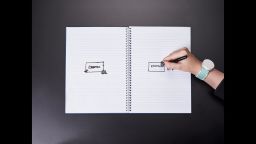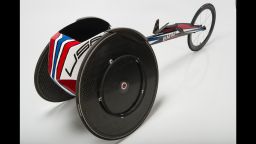Story highlights
The Cooper Hewitt, Smithsonian Design Museum show features more than 70 designs
The "Access+Ability" exhibition will be showcased at the museum until September 3
Eye-catching objects designed for, and by, people with physical and other disabilities are the focus of the current “Access+Ability” exhibition in New York.
More than 70 exhibits, including colorful prosthetic leg covers and jeweled earrings that are also hearing aids, are featured as examples of “inclusive design” at the Cooper Hewitt, Smithsonian Design Museum.
“There has been a surge of design with and by people with a wide range of physical, cognitive, and sensory abilities,” according to the museum’s website.
The new exhibit – like the museum itself – aims to reflect that trend. “This year Cooper Hewitt embarked on a very ambitious initiative about accessibility, about making our campus, our program, who we are, much more accessible and it seemed like the perfect moment to do the exhibition ‘Access + Ability,’ ” said Cara McCarty, the museum’s curatorial director.
Behind the exhibition
McCarty has long been interested in inclusive design. “Access+Ability” is her second exhibition focused on design for people with disabilities.
The first was in 1988 at New York’s Museum of Modern Art. It was called “Designs for Independent Living.”
“It was the first museum exhibition to really showcase well designed, highly functional products for people with physical disabilities,” McCarty said.
Her inspiration for that project came while she was on vacation in Sweden and Finland, where, she said, she saw many “beautiful well-designed products” for people with disabilities.

Thirty years later, McCarty said, she sees an important change in contemporary design. Digital technology is created not only for individuals with physical disabilities but for those with cognitive and sensory disabilities.
“The iPhone is very inclusive and has a lot of accessibility features on it. Somebody who is blind can use the same iPhone as someone who is sighted,” she said.
There is still a lot of work to be done, she said. “Accessibility is a human right, and that is a very big driver in the advances of making facilities accessible, but we definitely have a long way to go in our communities,” she said.
Accessibility at Cooper Hewitt
The current exhibit is part of the museum’s own ongoing effort to become more accessible. “We are a national museum and a design museum. These are all about design challenges. A lot of this can be addressed through design, so what better place to really experiment, try, and even fail with examples and just keep pushing what we know and help to share it with others who are trying to do the same?” McCarty asked.
McCarty said Cooper Hewitt is having its entire facility assessed and evaluated to see how it can be made more accessible.

Some of the services already available for visitors are wheelchairs and portable stools, sign-language interpretation, touch tours, Braille signage and “Morning at the Museum,” a program for those with cognitive and sensory processing disabilities (such as those with autism, attention-deficit hyperactivity disorder and Down syndrome).
“Cooper Hewitt is committed to accessibility in its broadest sense, with exhibitions and programs that involve all communities in thinking about how design can empower users,” said Caroline Baumann, director of the museum.
Inclusive design
It’s important to consider a wide range of needs while designing, McCarty said. “The larger the user group we take into consideration throughout the design process, the more inclusive many of our products in our society will be. And that really means putting the user front and center throughout the process.”
Multiple examples of innovative inclusive design are on display in the exhibition. One is a voting booth created by global design company IDEO for the 2020 Los Angeles County elections. The booth allows voters to stand or roll up in a wheelchair. It’s electronic and is accessible in multiple languages, has built-in headphones and has a variable font for ease of use by the visually impaired.
Another is the FlyEase, a shoe inspired by Matthew Walzer, a teen with cerebral palsy. Nike wanted to help solve the challenge of tying shoelaces. Designers created a wrap-around zipper system that allows those wearing the shoe to slide their foot in from the back rather than from above. The shoe itself looks like a lot of stylish sports shoes and can be worn by anyone.
According to Cooper Hewitt, many of the designs on display in the exhibition allow those with disabilities to lead more independent lives and engage more fully in the world. “This notion of being able to live independently or do more things independently is huge for people’s dignity just being able to access the world and let people access them and their thoughts and connect,” McCarty said.
The future
McCarty said that today, there is greater general awareness of inclusive design issues than when she produced her first exhibit three decades ago.
“There are a lot of young people who are really interested in social impact design, who are really receptive to differences and diversity,” she said.
Her hope is that people visiting the exhibition “will get inspired by this and think about other applications for some of these products or technology.”
Follow CNN Health on Facebook and Twitter
McCarty has her own inclusive design ambitions. When asked if she could redesign anything, what would it be, McCarty said hospitals and rehab facilities, from the “complete patient experience” to the “overall physical environment.”
McCarty’s hope is that as a society, we become more aware of the challenges and issues the disabled community faces and we re-evaluate how we choose to design. “It is all an education and awareness-building process.”
The museum, on Manhattan’s Upper East Side, is open from 10 a.m. to 6 p.m. weekdays and Sundays and 10 a.m. to 9 p.m. Saturdays. “Access+Ability” runs through September 3.










